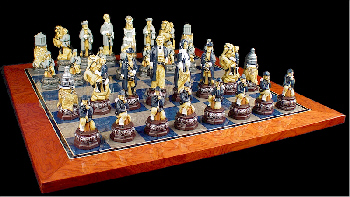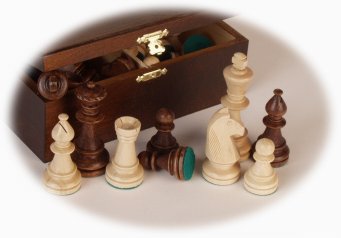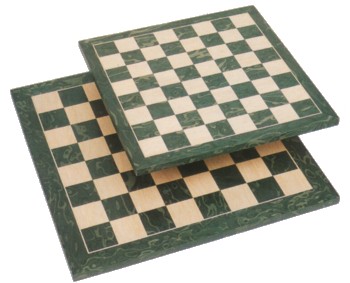|
|
||||||||||||||||||
 |
||||||||||||||||||
 |
|
I’m always on the lookout for new gaming groups, so last week I joined a group of high-school kids playing a hot new miniatures game near my house. The turnout was quite good, and resembled a DBA tournament, with dozens of games going on simultaneously. The tournament was a single player per side, though the table was a bit smaller than the standard 24” square DBA uses. The game is called Chess. And One Rule Set To Rule Them All And In the Darkness Bind Them The basic rules for Chess are free. The basic rules appear to be applicable to all periods from Ancients to Future (I think there may be period specific supplements, but I did not see any there that day). I must say they are very disappointing. They read like a child’s game, and take no advantage whatsoever of any of the newer game mechanics we have all come to know and love. Game Scale: There is no game scale that I can find. Figure basing is left entirely to the discretion of the player, as it is an area movement game. The board uses squares for areas (have you heard of hexagons? Hello?!?!). When I asked how long a turn was supposed to represent the players looked confused. One did mention something about Speed chess, but I thought I’d better stick to basics as it was my first time playing (well, watching really). Turn Sequence: Turn sequence is strictly IGOUGO. Each player (known simply as black or white) may activate one unit and move it. Combat is a function of movement. There is no command phase, no opportunity fire (no ranged fire at all in the basic rules), no counter-charge phase, and no time limit. A game lasts until one side wins or a draw is mutually declared (they call this a stalemate). Army Lists: The tournament that day featured a pretty big battle from what I could tell. Each player had 16 identical units, which pretty much filled up the deployment area (players were, I think, using a fixed or historical set-up). Here is a shot at the beginning of one game:
I think this is the one and only scenario provided with the rules, which may be why every game I saw used the same set up. Game Mechanics: Besides the willingness to play with unpainted figures (see below) the game mechanics were the most simple and disappointing I’ve ever run across. In essence each piece has a movement pattern - some may only move along diagonals, some are prohibited from doing so. The most common unit (“Pawns”) may only move one area, straight ahead, but may only attack enemy pieces in areas at a diagonal. Huh? You mean, I spend three turns marching up to a bishop (see below), stand right in front of him and can’t hurt him? You got it. Of course, depending on the kind of enemy unit he might not be able to hurt you either. Bishops can only move and attack along diagonals, for example. Even worse, the combat resolution is absurd. All attacks are automatically successful, and the only possible combat result is the complete elimination of the defender. There are no die roll modifiers of any sort. In fact it turns out there are no die rolls! Yeah, that’s really how combat works.... Scenarios: I asked about other scenarios or points values (when I asked how many points a rook cost someone accused me of being high!) but it appears no further scenarios have been provided. These darned kids seemed happy to play the same scenario over endlessly. They even recounted in excruciating detail move-by-move replays of this same scenario from last week, even last year! They would even play the same scenario 2 or 3 time running, just switching colors. Codexes: I asked someone for their Codex and got another of the blank stares that were becoming all too common. Each unit in the game has a name (the same for both sides). The names are King, Queen, Bishop, Knight, Rook, and Pawn. Everyone seem to have the same unit assortment (I assume they knew which scenario was being run and only brought the needed units as they all seemed to have identical armies. Nakes Figures: Worse still, these teenagers had no idea the figures were supposed to be painted. I explained how to do a basic block painting job and was told “who cares?” Apparently there are pre-painted armies available like this one for the ACW:
But the paint job is nothing special. here is a close up of one of the pawns:
Hold on to your hats - two 15mm armies like this one (32 figures in total) run $399! US! For poorly sculpted figures with only one highlight layer! GW eat your hearts out! This is what most of the kids used:
Don’t even get me started on the terrain:
As I said friends, the end is nigh. This page last updated: May 17, 2005 |
|
[Home] [15mm World] [Reviews Home] [How To] [Beginners Guide] [Gamer's World] [Spanner & The Yank] [Points of View] [The Annex] [Links] [Say Howdy] [Corporate Schill] [Rules Directory] |
 |




